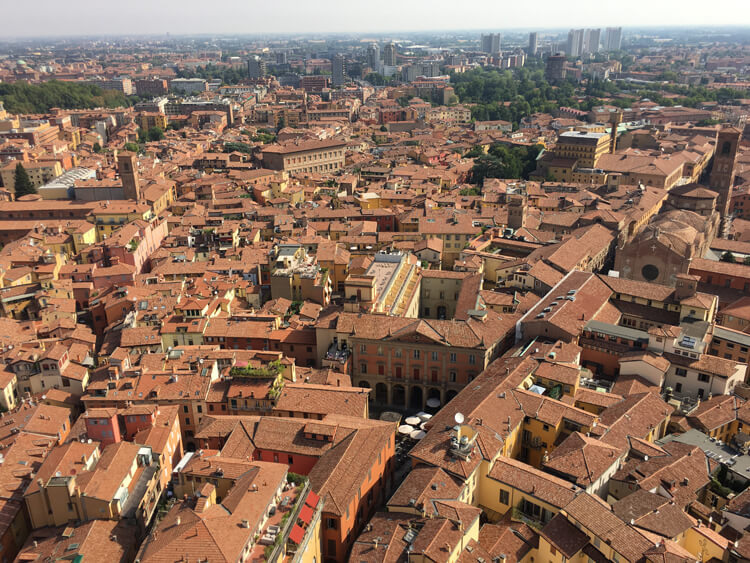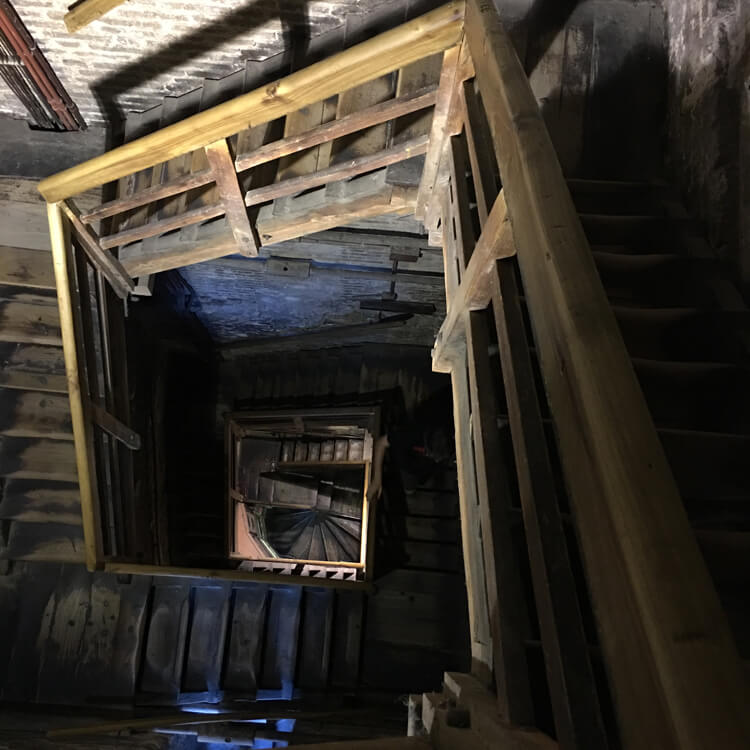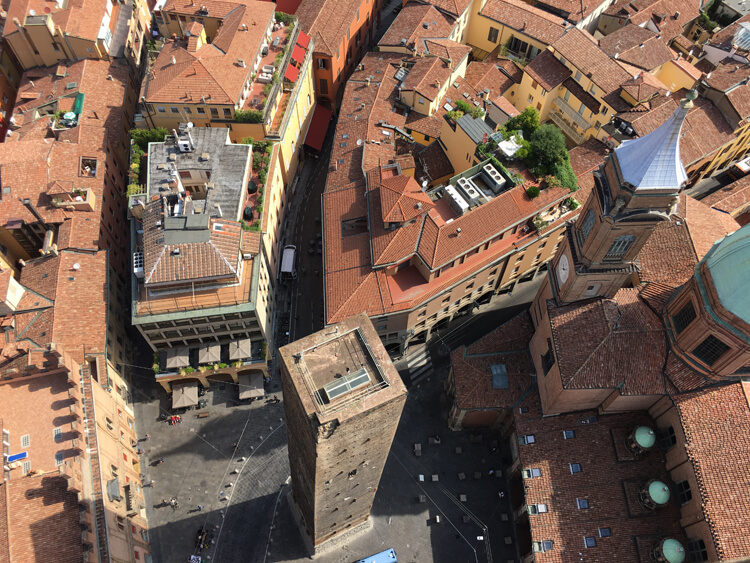
Climbing the Asinelli Tower is a quintessential Bologna experience. After all, the tower that has stood at the entrance to the heart of the city for nine centuries is, along with the Garisenda, which rises next to it, a symbol of Bologna – together, the Asinelli and the Garisenda are known as le Due Torri. They are especially beloved by the Bolognesi; we see them from so many different angles and observation points, it’s almost as if they were watching over us.
Indeed, the Asinelli Tower for centuries served as a lookout with defensive function. In the Middle Ages, Bologna had up to 180 towers, built both for prestige and protection. The Asinelli Tower, which takes its name from the family who built it, was erected between 1109 and 1119; it was originally ‘only’ 60-meter-high, and was later raised so it could be used to send luminous warning signals that would be seen far in the distance.
During the 14th century, it was temporarily connected to its shorter ‘sister’, the Garisenda Tower, through wooden scaffolding placed 30 meters above the ground.
Through the centuries, the Asinelli Tower has withstood earthquakes, fires, and lightning (and we love it even more for that ;-)). During World War II, it acquired its lookout function again: between 1943 and 1945, volunteers would stand at the top to direct rescue operations to the places struck by bombing.

What you need to know to climb the Asinelli Tower in Bologna
The Asinelli Tower (Torre degli Asinelli) has recently re-opened, after a three-month restoration aimed at strengthening the internal wooden staircases leading to the top and at restyling the rooftop terrace.
Located at Piazza di Porta Ravegnana, the Asinelli Tower is 97.2 meters high, the city’s tallest. To reach the top, you need to take 498 steps on steep wooden staircases. It is actually less strenuous than it sounds! If you get tired, there are platforms every few floors where you can rest.
Once you get to the top, the views of Bologna are truly stunning. I went up there today and they were even better than I remembered! You can see Bologna in every direction: its red roofs, towers and belfries; the green rolling hills that frame it to the south; the long, straight Via Emilia disappearing in the distance; Piazza Maggiore and the Basilica of San Luca; and more.



Be careful when you descend, as the stairs are steep and very narrow (not much room for your feet!).

Advance reservation is mandatory and you can buy your ticket (€5) at the Bologna Tourist Office on Piazza Maggiore 1/e or online at this website. You’ll need to select day and time of visit; this way, you’ll avoid lines, especially inside the tower as there’s no room on the stairs for two people to ascend and descend at the same time. In fact, if you keep your visit at 45 minutes, you won’t bump into people going up as you make your way down as groups depart every 45 minutes.
Opening times: March 1-November 5, 09:30 am-7:30 pm (last entry 6:30 pm); November 6-February 28, 09:30 am – 5:45 pm (last entry 5 pm).
The Asinelli Tower: A Love Story
Here’s a good story about the origin of the Asinelli Tower: in the 12th century, a poor bricklayer owned two small donkeys (asinelli in Italian) which he used to carry sand and gravel from the Reno river into the city. One day, as he was building the foundations of a house, the two donkeys started digging into the ground until a trunk full of golden coins emerged. Fearing that it could be taken away from him, the bricklayer hid the trunk and continued living his life as if he didn’t have the money. Time went by until his son fell in love with a young woman who belonged to a wealthy family. Her father said he wouldn’t let his daughter marry the bricklayer’s son unless the young man could build a tower that would be higher than all others in Bologna. Thus the bricklayer gave the golden coins to his son, who built the highest tower and married the woman he loved. The tower was named Torre degli Asinelli in honor of the animals that had found the treasure.
Fun fact: The Garisenda isn’t the only leaning tower of Bologna; the Asinelli leans too. It has an inclination of 2,23 meters (1.3°), which makes it the highest leaning medieval tower in Italy!

You might also like:


Hi, I was born in Bologna and I live in Bologna, but I never climb up the Torre degli Asinelli. After that very nice article I have to do it, absolutely!!! 😊
Yes, it’s fun to do and the views are awesome!!!
I climbed asinelli tower when i was a child, with my grandfather. Very good esperience
Wonderful!!
The article claims the tower leans 1.2 degrees, more than the leaning tower of Pisa.
I didn’t believe that so I googled it.
Pisa tower leans 3.99 degrees.
Before 1990 it leaned 5.5 degrees.
That’s when I climbed it 🙂
I love story about how the tower got its name!
The german poet Goethe did the same 1786:
“Toward evening I got out of this ancient, venerable, and learned city, and extricated myself from its crowds, who, protected from the sun and weather by the arched bowers which are to be seen in almost every street, walk about, gape about, or buy and sell, and transact whatever business they may have. I ascended the tower, and enjoyed the pure air. The view is glorious. To the north we see the hills of Padua; beyond them the Swiss, Tyrolese, and Friulian Alps,—in short, the whole northern chain, which at the time was enveloped in mist. Westward there stretched a boundless horizon, above which the towers of Modena alone stood out. Toward the east a similar plain, reaching to the shores of the Adriatic, whose waters might be discerned in the setting sun. Toward the south, the first hills of the Apennines, which, like the Vicentine Hills, are planted up to their summits, or covered with churches, palaces, and summer-houses. The sky was perfectly clear, not a cloud to be seen, only on the horizon a kind of haze…”
Beautiful description! Thanks so much for sharing!!